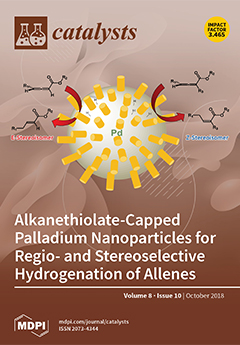1
A. N. Nesmeyanov Institute of Organoelement Compounds, Russian Academy of Sciences, ul. Vavilova, 28, Moscow 119991, Russia
2
People’s Friendship University of Russia, ul. Miklukho-Maklaya, dom 6, Moscow 117198, Russia
3
National Research Center “Kurchatov Institute”, pl. Akademika Kurchatova, dom 1, Moscow 123182, Russia
4
Institut des Biomolécules Max Mousseron (IBMM) UMR 5247, CNRS, Université de Montpellier, ENSCM, Université de Montpellier Campus Triolet Place Eugène Bataillon, 34095 Montpellier CEDEX 5, France
5
Semenov Institute of Chemical Physics, Russian Academy of Sciences, Ulitsa Kosygina, dom 4, Moscow 119991, Russia
6
Chair of Chemistry and Physics, Plekhanov Russian University of Economics, Stremyannyi pereulok, dom 36, Moscow 117997, Russia
Abstract
Unprecedented germanium-based sesquioxane exhibits an extremely high nuclearity (Cu
42Ge
24Na
4) and unusual encapsulation features. The compound demonstrated a high catalytic activity in the oxidative amidation of alcohols, with cost-effective catalyst loading down to 400 ppm of copper, and
[...] Read more.
Unprecedented germanium-based sesquioxane exhibits an extremely high nuclearity (Cu
42Ge
24Na
4) and unusual encapsulation features. The compound demonstrated a high catalytic activity in the oxidative amidation of alcohols, with cost-effective catalyst loading down to 400 ppm of copper, and in the oxidation of cyclohexane and other alkanes with H
2O
2 in acetonitrile in the presence of nitric acid. Selectivity parameters and the mode of dependence of initial cyclohexane oxidation rate on initial concentration of the hydrocarbon indicate that the reaction occurs with the participation of hydroxyl radicals and alkyl hydroperoxides are formed as the main primary product. Alcohols have been transformed into the corresponding ketones by the catalytic oxidation with
tert-butyl hydroperoxide.
Full article





